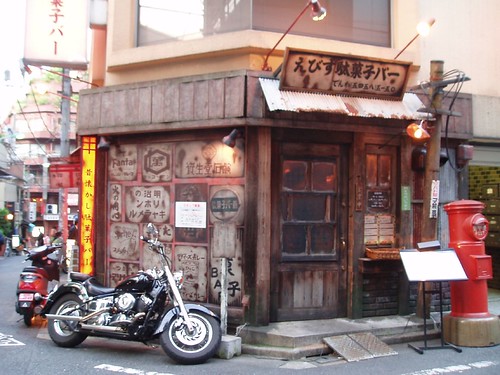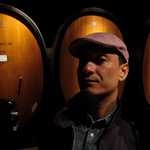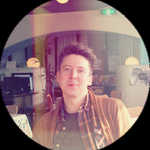The Snack Bar or Dagashi Bar in Japanese is on a corner of a small street, one block away from the lively food alley of Ebisu. If you didn’t know of its existence you would most likely miss it no matter how many times you walk by: it’s a dump. 
See?
In the dark the Snack Bar looks even more tattered. Metal signs are carelessly slathered onto the shack’s walls that are bleeding with rust. The front of the bar is un-inviting like the owners purposely neglected renovating to keep strangers out. I’ve come to learn the run-down look is the Snack Bar’s signature to give a retro feel.
The Snack Bar - Dagashi Bar is its name in Japanese. Dagashi are cheap snacks ranging from candy to crackers, chocolates to cakes, juices and gummies and sugared powder (like Pixi Sticks) and lots more. They are individually packaged made especially for children to easily afford with their very small allowances.
In the 70s and 80s, these snack shops (dagashi ya) were common place. I remember hanging out at the local ones near relatives’ homes. We would play with other neighborhood children inside the stores and out front in the streets. The people who tended the stores were perhaps the most memorable. For some reason, these snack shops were owned by ancient people. And when I say ancient, the shop keepers all seemed over a 100 years old, with worn-out wrinkled worker hands and sun stained faces. They treated all the children like their own — scolding us if we misbehaved and lecturing us on how to become better humans. I now wish I listened to the “when I was your age…” stories more carefully. I can’t begin to imagine what it was like to grow-up in their era: the Showa period.
The Showa period from 1920-1989 was when Japan dramatically changed. It’s hard to fathom that in a mere 70 or so years, Japan transitioned from farmlands to poverty stricken evidence of pre and post war eras, to a defeated and occupied country post WWII. Japan then catapulted into a progressive nation with the industrial revolution and now, comfortable stagnation from the bubble bursting. This changed happened so rapidly, certain parts of the country and even Tokyo, haven’t kept up with the shifts. Which is most likely why there is so much new mixed in with the old, ultimately creating this historically rich, mystical land. Uncovering the layers of Japan takes years, perhaps decades. What makes me love Japan so much, is the process of peeling back the layers and coming across things that make zero sense or sometimes, they are the answer to questions. It’s an unsettling, wondrous, peaceful land that I cannot get enough of.
In Japanese, ‘Showa’ is often times used as an adjective to signify retro. There’s a look and feel that is very Showa specific retro. If you punch 「昭和」in Instagram’s hashtag search for example, there are many photos that can give one an idea of what Japanese retro is.
From the raggedy retro exterior to the concept of eating dagashi while drinking, the Snack Bar is Showa nostalgia at its finest. The tradition of growing up eating cheap snacks still continues in modern times. Except now, the cheap snacks are purchased at supermarkets and convenience stores vs. traditional snack shops that are near extinct in Tokyo. Still, dagashi is associated with a retro feeling that brings waves of happy sentiments even children who have never stepped foot in an old school dagashi store know.
When you enter the Snack Bar it’s a bit overwhelming. The entrance is lined with bins of colorful little gummies and piles of funny looking packages. The pictures on the wrappers aren’t really helpful unless you read Japanese. And even if you read Japanese, some of the snacks remain a mystery. There are grown-ups squealing with delight like children, shouting across the room to their friends about their finds. Baskets on baskets overfilling with snacks are dangling near your heads. No matter how many times I go, it’s like my first time.
The staff barely speaks English but the menus have photos. The drinks at the Snack Bar are so cheap I have people order their own. Most look at me helplessly but this is what a local experience is. Adapt! As soon as drink orders are placed, the staff brings plastic bags to discard the snack wrappers. Annnnnd game on. You grab a tiny basket for yourself, fill it up with as many snacks as you want. Every day is Halloween at the Snack Bar. Oh. I forgot the most important bit: the snacks are all you can eat. They charge a sitting fee of 550 yen. (I’d be willing to pay double, even triple that, to support this bar.) Because the snacks are unlimited, I tell all visitors: try everything once. If you don’t like it, bin it and move on to the next.
So here we are, at a table for seven. Everyone is a bit confused by what is going on. I was actually very impressed by the three out of towners. They went with the flow and started eating — even snacks I wouldn’t touch. While we are trying to decipher what are in the little packages, Luis, Adrian and Graeme pull out their notebooks.
Luis carries a pen case that is a cylindrical treasure chest stuffed with shades and variants of pens I wouldn’t know what to do with. He chooses his pens swiftly and meticulously like a hunter focused on his prey. He has immediately tuned out the noise, sketching away. Adrian is next to me trying to process the slightly chaotic Snack Bar. He too, pulls out his notebook and starts flipping through it, almost like he is searching for his zen. Graeme, the Scot visiting Tokyo from Kobe (a region in southern Japan), is the only Scot I’ve met who doesn’t drink. I can’t even begin to imagine what was going through his clear, sober mind. I’m in awe that he was shoveling one snack after another into his mouth while us drunks continued washing down tens of snacks with cheap drinks. Poor Sophie from the Netherlands is observing the scene. She is so laid back I think the Snack Bar frenzy may have been too much for her. She graciously kept a pleasant demeanor and elegantly nibbled on.
The dust settles on the initial excitement, and I get the honor of flipping through Adrian’s coveted notebook. Boy, is he talented.
To be cont…
Snack Bar (Dagashi Bar) Ebisu
http://www.dagashi-bar.com/shoplist.html#ebi
(sorry, in Japanese only)
Actually, I reckon the Snack Bar is easier to accept when you are in holiday mode. Locals should only go if they are in a IN YOUR FACE TOKYO type mood.
Luis is of course, super talented Luis Mendo
Hi: https://hi.co/people/luis
site: http://www.luismendo.com/
Insta: @luismendo
Twitter: @luismendo
Adrian Hogan
site: adrianhogan.com
Insta: @adehogan
Twitter: @adehogan
*header photo is Adrian’s notebook and the Snack Bar’s table.
Graeme goes by From Sand to Sky
site: fromsandtosky.com
Insta: @fromsandtosky
Twitter: @fromsandtosky
He also has books for sale in Tokyo here: http://www.nadiff.com/
Other moments in Tokyo
-
Conversations, World Affairs, Culture
"I'm from Libya," he said. I don't know what to say. It's as if he'd told me he'd just come from his father's funeral.
in Tokyo, Japan -
The first specialty coffee shop in Ikebukuro and Junkudo (bookstore) resonate.
in Tokyo, Japan -
film, edit
Editing is interpreting.
in Tokyo, Japan -
The Riddle of Steel.
in Tokyo, Japan -
Commutes, Cities, Underground
The man stands motionless in a crush of white-shirted salarymen, as they swarm past him, toward the single escalator.
in Tokyo, Japan -
Reve, japan, Centre commercial piscine
Rêve de centre commercial-piscine
in Tokyo, Japan -
Urban Nature, birds
Sparrow Noise
in Tokyo, Japan -
City walks
Birthday walk home
in Tokyo, Japan -
Dead Letter, Addiction
"Dear Cigarettes"
in Tokyo, Japan






















